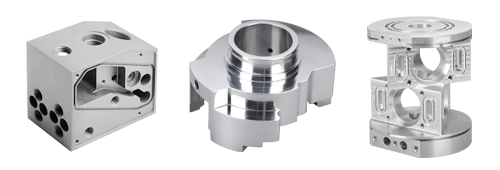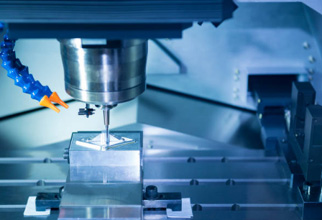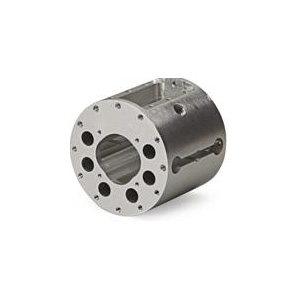Get our quotes on custom CNC manufacturing for your prototypes and production parts.

CNC for your prototypes and production parts.
Get Your Quote All uploads are secure and confidential.
All uploads are secure and confidential.
CNC uses automated, high-
speed cutting machines to form shapes from metal stock. 3-axis, 4-axis, and 5-axis mills, lathes, and routers are standard CNC machines. The workpiece
may stay in place while the tool moves, the tool may stay in place while the workpiece is rotated and moved, or both may move together.
Skilled machinists programme CNC machine tool paths depending on part geometry. CAD models give part geometry information. CNC machines can cut
almost any metal alloy with great precision and repeatability, making custom manufactured parts appropriate for industrial, electronics, medical, robotics,
and aerospace use. DS offers custom CNC quotes on over 40 materials, from aluminium to titanium.

DS provides CNC turning , CNC milling and gear hobbing services,. Learn more about what services we offer.
CNC turning is the optimal method for producing all types of cylindrical shapes with superior surface finishes, as well as deep holes, machined threads, and threads. CNC turning at DS is your choice when you need precisely made parts, rapid turnaround, and no volume constraints. Find out more about how we can assist you.
Get Your Quote CNC TurningCNC milling creates complicated prismatic forms and flat surfaces for an unlimited number of commercial and industrial items. Multi- axis metal CNC machines require no fixed tooling, are highly flexible, and extremely accurate. Learn more about how we can help your most complex CNC milling projects regardless of their size.
Get Your Quote CNC MillingCNC milling creates complicated prismatic forms and flat surfaces for an unlimited number of commercial and industrial items. Multi- axis metal CNC machines require no fixed tooling, are highly flexible, and extremely accurate. Learn more about how we can help your most complex CNC milling projects regardless of their size.
Get Your Quote Gear Hobbing|
CNC Machining Tolerances |
|
|
Feature |
Description |
|
Maximum Part Size |
Milled parts up to 950 x 550 x 480 mm (37.0 x 21.5 x 18.5 inch) Lathe parts up to 1,575 mm ( 62” ) length and 813 mm ( 32”) diameter. |
|
Linear dimension |
+/- 0.025 mm +/- 0.001 inch |
|
Hole diameters (not reamed) |
+/- 0.025 mm +/- 0.001 inch |
|
Shaft diameters |
+/- 0.025 mm +/- 0.001 inch |
|
Surface roughness |
0.8 μm Ra 0.4 μm Ra |
CNC machining has a wide range of materials accessible for custom prototypes and manufacturing parts, ranging from hard metals like stainless steel and titanium to soft metals like aluminium, copper, and brass etc.
| Material | Available Varieties |
| Aluminum | Aluminum 5052, |
| Aluminium 6082- T6 | |
| Aluminum 7075- T6, | |
| Aluminum 6063- T5, | |
| Aluminum 6061- T6, | |
| Aluminum 2024- T3 | |
| Brass/Bronze | Brass C360, |
| Brass 260, | |
| C932 M07 Bearing Bronze | |
| Copper | EPT Copper C110, |
| Copper 101 | |
| Steel | Alloy Steel 4130, |
| Alloy Steel 4140, | |
| ASTM A36, | |
| Stainless Steel 15 -5, | |
| Stainless Steel 17 -4, | |
| Stainless Steel 18 -8, | |
| Stainless Steel 303, | |
| Stainless Steel 304, | |
| Stainless Steel 316/316L/316F | |
| Stainless Steel 416, | |
| Stainless Steel 420, | |
| Steel 1008, | |
| Steel 1018, | |
| Steel 1020, | |
| Steel 1045, | |
| Steel A36 | |
| Nickel | Nitronic 60 |
| Nickel alloy | |
| Kovar | Kovar alloy |
| Titanium | Titanium alloy |
|
Design Guildlines |
|
|
Feature |
Description |
|
Internal corner fillets |
Design internal corner fillets to be 0.020” - 0.050” greater than a standard drill size for the radii. Follow a drill diameter to depth ratio of 1:6 (1:4 recommended) as a guideline for internal corner radii. |
|
Floor fillets |
Design floor fillets smaller than corner fillets to allow the same tool to clear material from the interior. |
|
Undercuts |
Always design undercuts to standard sizes and away from corners so they are accessible by the cutting tool. |
|
Tapped/threaded hole depth |
Provide tool clearance slightly beyond the tapped hole depth to ensure complete threads. |
|
Complexity |
Keep the number of small cuts to a minimum to reduce CNC machining costs; only design in the necessary features to balance function with aesthetic. |
| Maximum Part Size |
Milled parts up to 950 x 550 x 480 mm (37.0 x 21.5 x 18.5 inch) |
|
Lathe parts up to 1,575 mm ( 62” ) length and 813 mm ( 32”) diameter. |
|
| Linear dimension |
+/- 0.025 mm |
|
+/- 0.001 inch |
|
| Hole diameters (not reamed) |
+/- 0.025 mm |
|
+/- 0.001 inch |
|
| Shaft diameters |
+/- 0.025 mm |
|
+/- 0.001 inch |
|
CNC machining enables the production of components and
parts that would be impossible to produce manually. A single set of instructions given into a computer can produce complex 3D products. Through
drilling, milling, turning, and other operations, the CNC machine removes material from the base stock piece to create shapes, angles, and the final
output.
CNC machining is adaptable and may be utilised with a variety of materials, including metals, plastics, wood, glass, foam, and composites. This versatility
has contributed to the widespread adoption of CNC machining across industries, allowing designers and engineers to create things efficiently and
precisely.
DS's CNC machining services can be used for rapid prototype and bulk manufacturing.
Here are some factors to consider.
Rapid removal of vast quantities of metal.
Highly precise and reliable.
Excellent for making complex geometries.
Versatile.
Compatible with numerous types of substrates.
Volumes scalable from one to a million.
Low investment in tooling and preparation cost.
Fast turnaround.
Parts are full-strength and can be put into service immediately.
Excellent surface finishes.
Easily customized.

Milling shapes the workpiece by using rotating multi-point
cutting tools. End mills, helix mills, and chamfer mills are examples of milling instruments that are either horizontally or vertically oriented.
CNC milling also makes use of CNC-enabled milling machinery, known as mill machines or mills, which can be horizontally or vertically oriented. Basic
mills can move in three axes, with more advanced models accepting additional axes. Hand milling, plain milling, universal milling, and omniversal milling
machines are all available.
To remove material from a rotating workpiece, turning uses
single-point cutting tools. The turning tool design varies depending on the application, with tools available for roughing, finishing, face, threading,
shaping, undercutting, parting, and grooving.
CNC-enabled lathes or turning machines are also used in the CNC turning process. Turret lathes, engine lathes, and special-purpose lathes are examples
of accessible lathes.
5 axis CNC machining is a numerically-controlled
computerised manufacturing technology that adds two rotational axes to the typical machine tool's 3-axis linear motions (X, Y, Z) to access five of six part
surfaces in a single operation. By adding a tilting, rotating work holding fixture (or trunnion) to the work table, the mill becomes a 3+2, or indexed or
positional, machine, allowing the milling cutter to approach five out of six sides of a prismatic workpiece at 90° without resetting the workpiece.
The fourth and fifth axes don't move during milling. Adding servomotors to the additional axes and CNC would make it one. Such a machine is dubbed a
"continuous" or "simultaneous" 5-axis CNC mill. Two additional axes can be added to the machining head or split between the table and head.
CNC machines are incredibly versatile and serve many
industries. Metalworkers use them for drilling and routeing. Aerospace prefers CNC machining because it gives 5-axis options. This allows them to cut
Inconel.
CNC machining is crucial in the medical business for micro-machining tiny parts created from various materials for life-saving functions. CNC machining is
used to create pacemaker parts, titanium joints, and medical instruments.
When you think of automation and machines, what comes to mind first? Many would say the auto industry. Consider the shafts, gears, pins, and
brackets in cars. CNC machining is used to produce cars, trucks, and military vehicles.
Other CNC uses:
R&D/Prototyping
Consumer electronics
Robotics
Construction
Dental snacks
Agriculture
other consumer applications

In traditional machining, a machinist removes or shapes metal. Designers and engineers give requirements through an engineering sketch or blueprint. They employ turn wheels, dials, switches, chucks, vices, and hardened steel, carbide, and industrial diamond cutting tools to assure accurate dimensions.
CNC machining accomplishes the same functions as traditional machining, including metal cutting, drilling, milling, boring, grinding, and other metal forming and removal functions. Automated, code-driven, programmed. First-time and 500th-time cuts are equally exact. Widely use in digital manufacturing (and low-volume production runs) it can be changed and modified to accommodate alterations and changing materials.
This precision machining has largely replaced traditional machining in manufacturing, fabrication, and industrial output. It uses mathematical coordinates and computational power for accuracy. CNC employs Cartesian coordinates. These are multidimensional spatial coordinates with axes. Automated cutting tool machines use a computer to control cutting, boring, drilling, and other operations. In the product's digital drawing and design, engineers marked these coordinates.
Most of our quotes are delivered within 24 hrs. and usually in much less time, depending on project details.
Our team will contact you directly about your CNC machining quote to ensure you’ve received and understand all aspects of your quotation and to
answer any questions you may have about your options.

Download the DS. CNC Technologies Quick
Reference Gulde: tolerances, capabilities and
equipment used at Ds CNC
Questions about CNC machining or advanced
metrology? Contact us using the form below:
 Download
The CNC Machining Whitebook Here
Download
The CNC Machining Whitebook Here